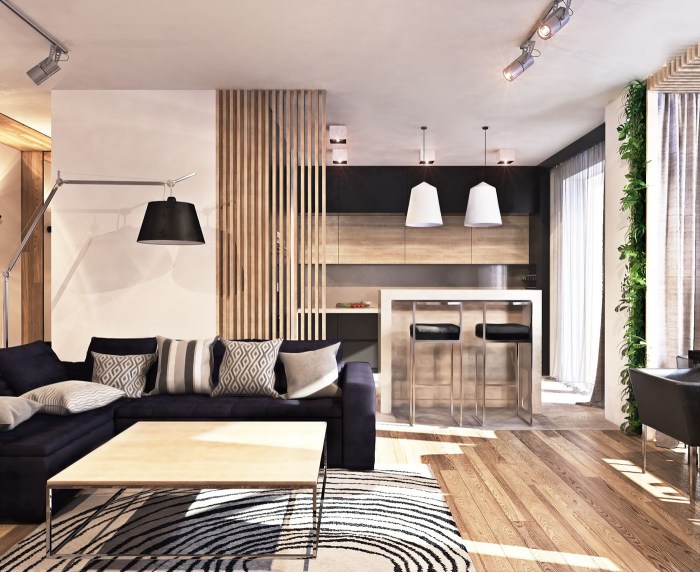Crafting Captivating Interior Spaces: A Comprehensive Guide

As interior spaces take center stage, this opening passage beckons readers into a world crafted with good knowledge, ensuring a reading experience that is both absorbing and distinctly original.
Interior spaces play a crucial role in our daily lives, impacting our mood, productivity, and overall well-being. From the color schemes to spatial planning, each element contributes to creating a harmonious and functional environment. Let's delve deeper into the world of interior design and explore the intricate balance between functionality and aesthetics.
Importance of Interior Spaces
Interior spaces play a crucial role in our daily lives, influencing our mood, productivity, and overall well-being. A well-designed interior space can have a significant impact on how we feel and behave, creating environments that promote creativity, relaxation, or focus.
Impact on Mood and Productivity
Interior spaces that are thoughtfully designed with elements such as natural light, comfortable furniture, and calming colors can have a positive effect on our mood. A well-lit and organized space can boost our energy levels and motivation, leading to increased productivity.
Influence on Behavior and Emotions
The layout and design of interior spaces can also influence our behavior and emotions. For example, open and collaborative workspaces can foster communication and teamwork, while cozy and intimate settings can promote relaxation and reflection.
Examples of Famous Interior Spaces
- The Sistine Chapel in Vatican City is known for its awe-inspiring interior with intricate frescoes painted by Michelangelo, evoking a sense of wonder and spirituality.
- The Guggenheim Museum in New York City, designed by Frank Lloyd Wright, features a unique spiral design that guides visitors through the space in a fluid and dynamic way, creating a sense of movement and exploration.
- The Palace of Versailles in France showcases opulent interior spaces adorned with luxurious furnishings and ornate decorations, reflecting a grand and majestic atmosphere.
Elements of Interior Design

Interior design encompasses a variety of elements that come together to create a cohesive and visually appealing space. Understanding these key elements is essential for designing interiors that are both functional and aesthetically pleasing.
Color
Color is a fundamental element of interior design that can set the tone for a space. Different colors evoke different emotions and can dramatically impact the overall feel of a room. Warm colors like red and orange can create a cozy atmosphere, while cool colors like blue and green can promote a sense of calmness.
Texture
Texture adds depth and visual interest to a space. By incorporating a mix of textures such as smooth, rough, shiny, and matte, you can create a dynamic environment that feels rich and layered. Texture can also influence how light interacts with surfaces, adding another dimension to the design.
Furniture
Furniture plays a crucial role in interior design by providing both function and style. The choice of furniture pieces can define the overall style of a space, whether it's modern, minimalist, traditional, or eclectic. It's important to select furniture that not only fits the aesthetic of the room but also meets the needs of the occupants.
Lighting
Lighting is an essential element that can transform the mood and ambiance of a room. Natural light can make a space feel open and inviting, while artificial lighting can be used to highlight specific areas or create a cozy atmosphere.
A well-designed lighting plan considers both the functionality and aesthetics of the space.
Pattern
Patterns can add visual interest and personality to a room. Whether through textiles, wallpaper, or decorative accessories, patterns can be used to create a focal point or tie together different elements in a space. Mixing patterns effectively requires an understanding of scale, color, and repetition.
Space Planning
Effective space planning is crucial for optimizing the functionality and flow of a room. It involves arranging furniture, creating traffic paths, and defining zones to ensure that the space is both visually appealing and practical. Good space planning maximizes the use of space while maintaining a sense of balance and harmony.
Functionality vs. Aesthetics
When it comes to interior design, finding the balance between functionality and aesthetics is crucial. While aesthetics focus on the visual appeal and beauty of a space, functionality ensures that the space serves its intended purpose effectively.
The Importance of Practicality in Interior Design
Practicality plays a significant role in interior design as it determines how well a space can be used and enjoyed by its occupants. A well-designed space should not only look good but also be practical and functional in its layout and use of materials.
- Utilizing multifunctional furniture: Incorporating pieces that serve more than one purpose, such as a sofa bed or storage ottoman, can maximize space efficiency without compromising aesthetics.
- Strategic lighting design: Lighting not only enhances the visual appeal of a space but also contributes to its functionality by creating the right ambiance and improving visibility for various tasks.
- Optimizing storage solutions: Clever storage solutions like built-in shelves, hidden cabinets, and under-stair storage help maintain a clutter-free environment while adding to the overall aesthetic of the space.
Color Schemes and Lighting
Color schemes and lighting play a crucial role in shaping the look and feel of interior spaces
Significance of Color Schemes
Color schemes are essential in setting the tone of interior spaces. They can evoke different emotions and create various atmospheres. For instance, warm colors like reds and yellows can make a room feel cozy and inviting, while cool colors such as blues and greens can create a calming and serene environment.
- Neutral color schemes are versatile and timeless, suitable for creating a sophisticated and elegant look.
- Monochromatic color schemes involve using different shades of the same color for a harmonious and cohesive feel.
- Complementary color schemes utilize colors that are opposite each other on the color wheel to create a vibrant and dynamic space.
Choosing the right color scheme is crucial as it can influence the perception of space and impact the overall experience of the occupants.
Impact of Lighting
Lighting is another crucial aspect that can greatly influence the perception of space and mood. The intensity, color temperature, and placement of lights can dramatically alter the look and feel of a room.
- Natural light can make a space feel bright and airy, enhancing the overall ambiance.
- Task lighting is important for specific activities like reading or cooking, providing focused illumination where needed.
- Ambient lighting sets the overall mood of a space, creating a warm and inviting atmosphere.
Proper lighting design is essential to highlight key features, create focal points, and enhance the functionality of the space.
Choosing the Right Colors and Lighting
When selecting colors and lighting for different types of interior spaces, it's important to consider the function of the space, the desired mood, and the overall design aesthetic. For example, a workspace may benefit from bright, energizing colors and task lighting to promote productivity, while a bedroom may require soft, soothing colors and dimmable lighting for relaxation.
- For small spaces, light colors and ample natural light can create a sense of openness and airiness.
- In areas meant for social gatherings, warm and inviting colors with layered lighting can promote a cozy and welcoming atmosphere.
- Experimenting with accent lighting and bold color choices can add personality and visual interest to a space.
Spatial Planning and Layout
In interior design, spatial planning and layout play a crucial role in creating functional and aesthetically pleasing spaces. It involves organizing and arranging the furniture, fixtures, and elements within a room to optimize the use of space.
Furniture Arrangement for Functionality
- Consider the function of the space: Before placing furniture, determine the primary function of the room to ensure that the layout supports its intended use.
- Allow for circulation: Ensure there is enough space for people to move around comfortably without obstacles. This can be achieved by creating clear pathways between furniture pieces.
- Balance and proportion: Arrange furniture in a way that creates a sense of balance and proportion within the room. This can help in creating a harmonious and visually appealing layout.
Creating a Harmonious Flow
- Consistency in style: Choose furniture and decor elements that complement each other in style, color, and scale to create a cohesive look throughout the space.
- Zoning: Define different zones within a room for specific activities, such as a seating area, a dining area, or a workspace. This can help in organizing the space effectively.
- Use of focal points: Highlight a focal point in the room, such as a fireplace, a piece of artwork, or a statement furniture piece, to draw attention and create visual interest.
Conclusive Thoughts
In conclusion, the art of interior design is a delicate dance between form and function. By understanding the importance of well-designed interior spaces, we can transform our surroundings into spaces that not only look beautiful but also enhance our daily lives.
Whether it's choosing the right color schemes or optimizing spatial layouts, the key lies in creating spaces that resonate with our emotions and behaviors. Dive into the world of interior spaces and unleash your creativity to craft spaces that truly inspire and uplift.
FAQ Guide
How do interior spaces impact mood and productivity?
Well-designed interior spaces have the power to uplift moods and boost productivity by creating environments that are visually appealing and functional.
What are the key elements of interior design?
The key elements include color schemes, lighting, furniture arrangement, and spatial planning, all of which contribute to creating a cohesive and well-designed space.
How can I balance functionality and aesthetics in interior spaces?
It's essential to prioritize practicality while also paying attention to the aesthetic appeal of a space. By finding a balance between the two, you can create interior spaces that are both functional and visually pleasing.

